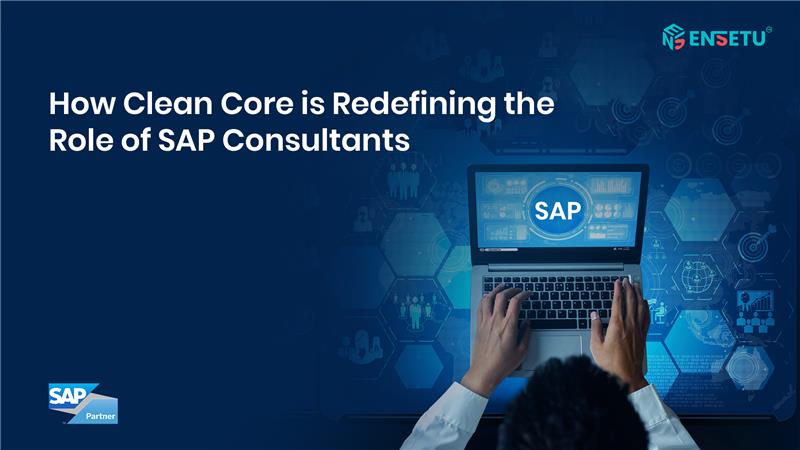
In the world of SAP consulting, a transformative shift is under way. Clean Core stresses the importance of respecting the SAP S/4HANA core as much as possible by avoiding in-core changes, and instead taking advantage of structured, cloud-compliant, extensibility (after consultation with SAP). SAP’s own course materials note that Clean Core consisted of removing custom organizations, duplicates, and table copies, and substituting Git Hub documented and supported (and upgrade-stable), interfaces, key-user in-app extensibility, or side-by-side solutions with BTP and Integration Suite.
This design principle helps to achieve and retain all of the expected maintenance, upgrade-ability, and SAP best-practice upgrades that will reduce total cost of ownership and more effective governance.
4 Reasons Organizations Adopt a Clean Core
Organizations that have adopted a Clean Core are finding the following benefits:
• Simple Upgrade and Reduce Technical Debt – By reducing custom code there are fewer custom implementations to maintain and upgrade.
• Improved Performance and Reliability – Clean core implementations cleaned up existing processes; one implementation gave back real-time for the business, and disruptions to the business became more infrequent.
• Speed of Innovation – With SAP BTP providing extensibility with modular approaches such as AI, automation, and microservices, organizations are innovating faster than ever with less dependency on the core.
• Governance and Data Quality – Reduced complexity of data, and controlled flexibility has provided organizations with cleaner chart of accounts, fewer unmatched items, and stronger governance especially in tax functions.
The New Role of SAP Consultants
With Clean Core as the guiding principle, consultant roles now extend well beyond technical implementation. Let’s look at how the responsibilities are evolving.
1. From Custom Development to Extensibility Design
Traditional consultants often relied on RICEFW (Reports, Interfaces, Conversions, Enhancements, Forms, Workflow) and in-core ABAP modifications. Clean Core shifts this to designing extensions via SAP BTP, public APIs, and key-user in-app tools. Instead of building inside the system, consultants now design with modularity and upgrade safety in mind.
As one commenter on the SAP community put it, Clean Core is the future—and consultants must now understand CDS architecture, embedded ABAP cloud (“steampunk”), and BTP development patterns.
2. Strategic Architecture and Governance Leadership
Consultants must inspect any legacy code, remove unnecessary implementations, and design new extension landscapes that align with Clean Core. This can involve a variety of tools, such as, SAP’s Custom Code Migration App and Signavio for process analyses, and SAP’s Extensibility Guide for best practices.
Additionally, SAP’s expectation is that these consultants develop governance frameworks to ensure all extensions are Clean Core compliant and deploy governance at the interface points, the builds, and during migration planning.
3. Advocates of Change Management
Moving to Clean Core is as much about the people as it is the technology. Many organizations still resist the complete removal of legacy customizations. Successful consultants must act as change agents by communicating the benefits of Clean Core, and leading process simplification workshops and reframing customization as modular innovation, instead of technical debt.
4. Facilitators of Business-Driven Innovation
Clean Core consultants straddle the space of business needs and technical delivery. Their design-led approach helps to facilitate the transformation of business need into scale, cloud-native extensions delivered on SAP BTP, enabling new cloud capabilities such as AI, multi-purpose low-code applications, as well as data reporting and analytics, without polluting the core.
5. Preparing for Continuous Cloud-Based Evolution
Clean Core facilitates continuous updates. The consultant role is to provide ongoing stewardship – monitoring updates & release notes, validating that extensions remain intact, and working with the client to take advantage of the new SAP innovations/integrations while minimizing disruption.
Rewarding Challenges in Transitioning to Clean Core
Moving to Clean Core can be fraught with challenges:
• Complex Legacy Environments: Moving heavily customized environments to Clean Core can be complicated, as scoped greenfield or very carefully managed brownfield projects.
• Socialization of Stakeholders: Moving business users from their customized legacy way of working requires effective change management, communication and sound process redesign.
• Industry Considerations: In highly regulated industries such as pharma and finance, where bespoke workflows are often unavoidable, consultants frequently face the challenge of developing necessary extensions while still adhering to the discipline of Clean Core.
• Governance Gap: Without effective governance in place, extensions can easily shift in response to urgent needs back into the risky behaviors of prior to Clean Core and potentially jeopardize core integrity.
A Vision of the Future SAP Consultant
SAP consultants are adapting to an expanded and more strategic role. As expected, SAP consultants now act as architects. They are required to create a modular solution that has safe upgrade capabilities without compromising the integrity of the system. They also need to serve the governance role to ensure that clean “system” practices and technical hygiene exist at all times. They will also step into function of innovation facilitators using SAP BTP and integration capabilities and low-code tooling to deliver solutions in an agile manner while still aligned with the business.
Just as importantly, they must guide organizations through change, fostering a culture that prioritizes standard-first thinking over heavy customization. Finally, consultants take on the responsibility of being continuous stewards, helping clients adopt and sustain SAP’s cloud-native innovations through careful deployment and disciplined oversight. This evolution positions consultants not merely as technical implementers but as trusted strategic partners who drive long-term business value.
Conclusion
Clean Core is not simply a discipline of technology. It is also a strategic movement that positions SAP consultancy into sustainable architecture, agile innovation, and trusted stewardship.
When consultants adopt Clean Core, they help customers modernize their ERP landscape, reduce technical debt, and scale into the future. As the mindset shifts from customization-first to extensibility-first, consultants who embrace the principles and tools of Clean Core will be best able to maximize their potential to create business agility, needed value, and long-term preservation of their organizations and our world.